Cioppino (pronounced chuh-pee-no) is a famous seafood stew created by Italian-American immigrants in San Francisco. While related to many Italian and other Mediterranean fish stews this homey seafood stew recipe with halibut, shrimp, and mussels is an example of adaptation and ingenuity.
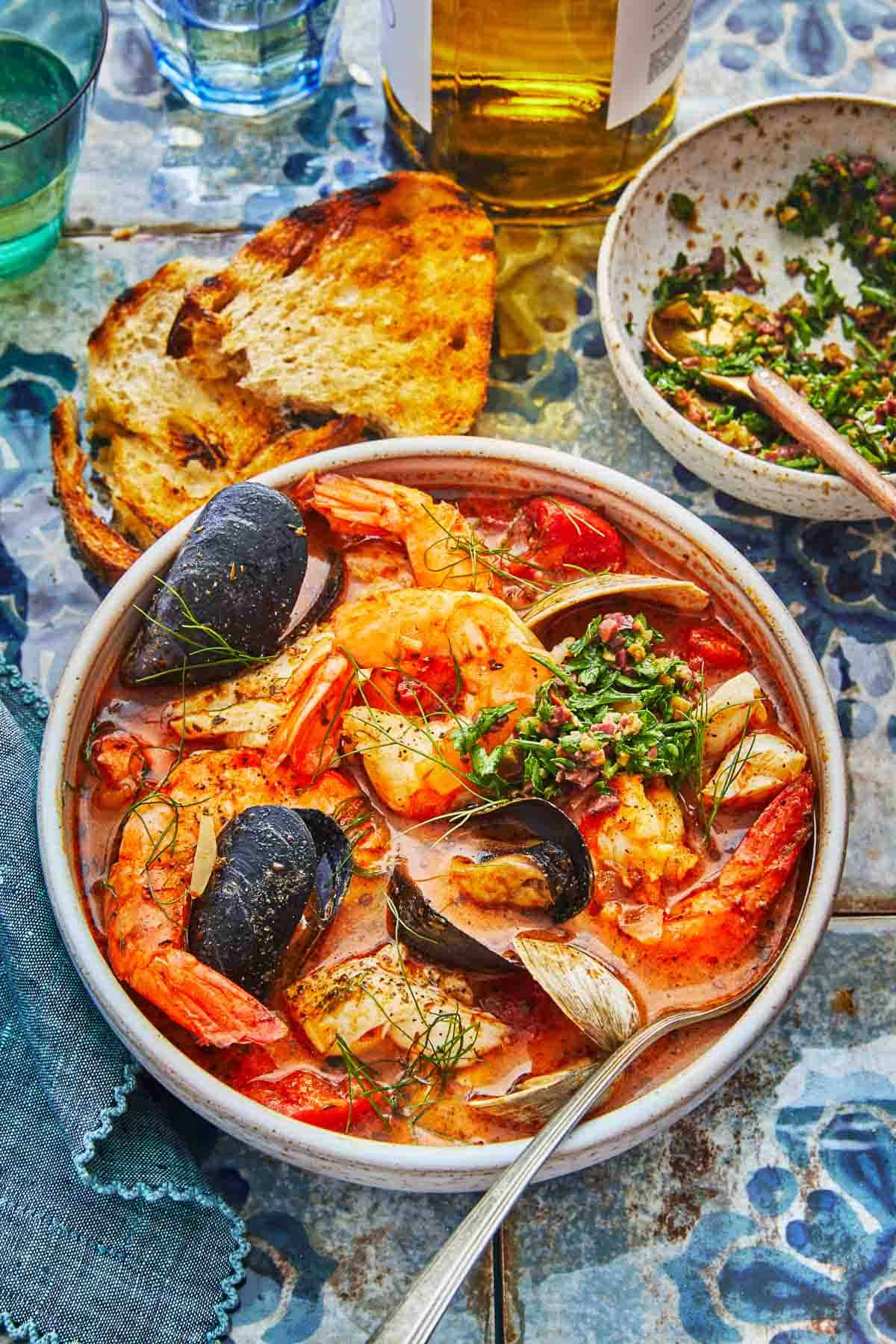
An intensely satisfying seafood stew containing a wonderful jumble of texture and flavor, this cioppino recipe combines a collection of clams, mussels, white fish and shrimp in a tomato-fennel broth. Our recipe makes a big batch of stew, so it’s perfect for the holidays – and if you celebrate the Feast of the Seven Fishes, you’ve knocked out four fishes in one dish! This stew has really become huge fan favorite, and it’s easy to see why.
Although there is some amount of work to be done in cleaning, deveining and otherwise prepping the seafood, once that is behind you the stew comes together very quickly.
This cioppino recipe makes for a showstopper Sunday supper, and is infinitely adaptable — substitute scallops for the shrimp, cockles for the clams or lobster for the white fish. Use whatever looks best at your fish counter!
I’ve included a recipe here for a Parsley-Olive Gremolata to add a pop of freshness to the finished stew. The combination of orange zest, garlic, parsley and olives bring a fragrant liveliness that contrasts nicely with the briny seafood.
Seafood is a key component of the Mediterranean diet, which is why you’ll find hundreds of healthy, hearty seafood recipes on the Mediterranean Dish. Once you’ve tried this briny and savory Cioppino recipe, test your kitchen skills with Steamed Mussels in White Wine or Baked Cod with Lemon and Garlic. Or, try your hand at another Italian classic: Linguine Alle Vongole (Linguine With Clams).
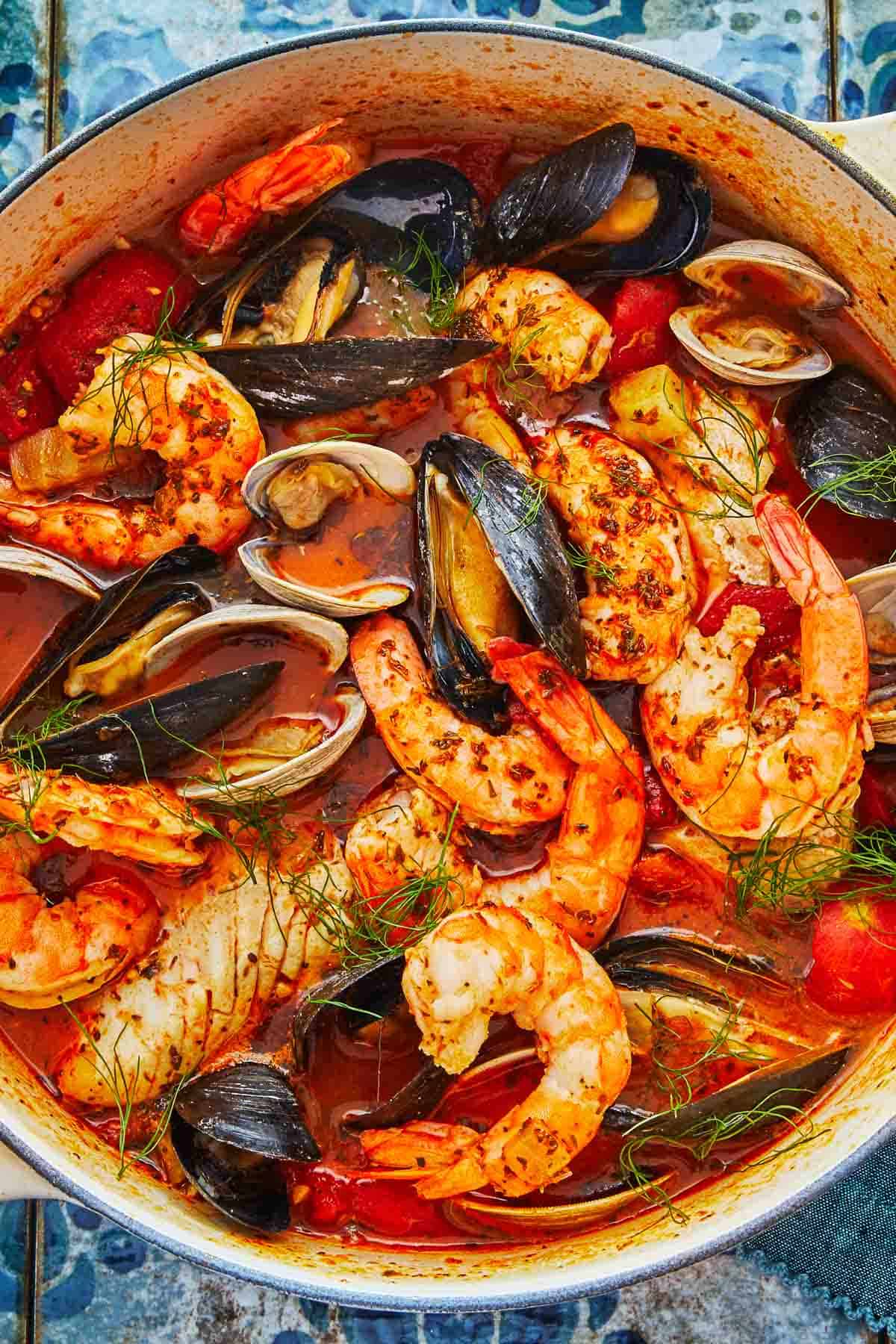
Table of Contents
What is Cioppino?
There are many stories about the origin of this stew, but all agree that it was created by Genoese immigrants using the Pacific seafood so abundant in their new home of San Francisco.
Similar to many fish-based stews found all over the Mediterranean such as Tuscan cacciucco or French bouillabaisse, cioppino recipes include infinite variations of seafood in a tomato and wine broth. True to its San Francisco origins, cioppino is traditionally served with grilled sourdough bread for dunking.
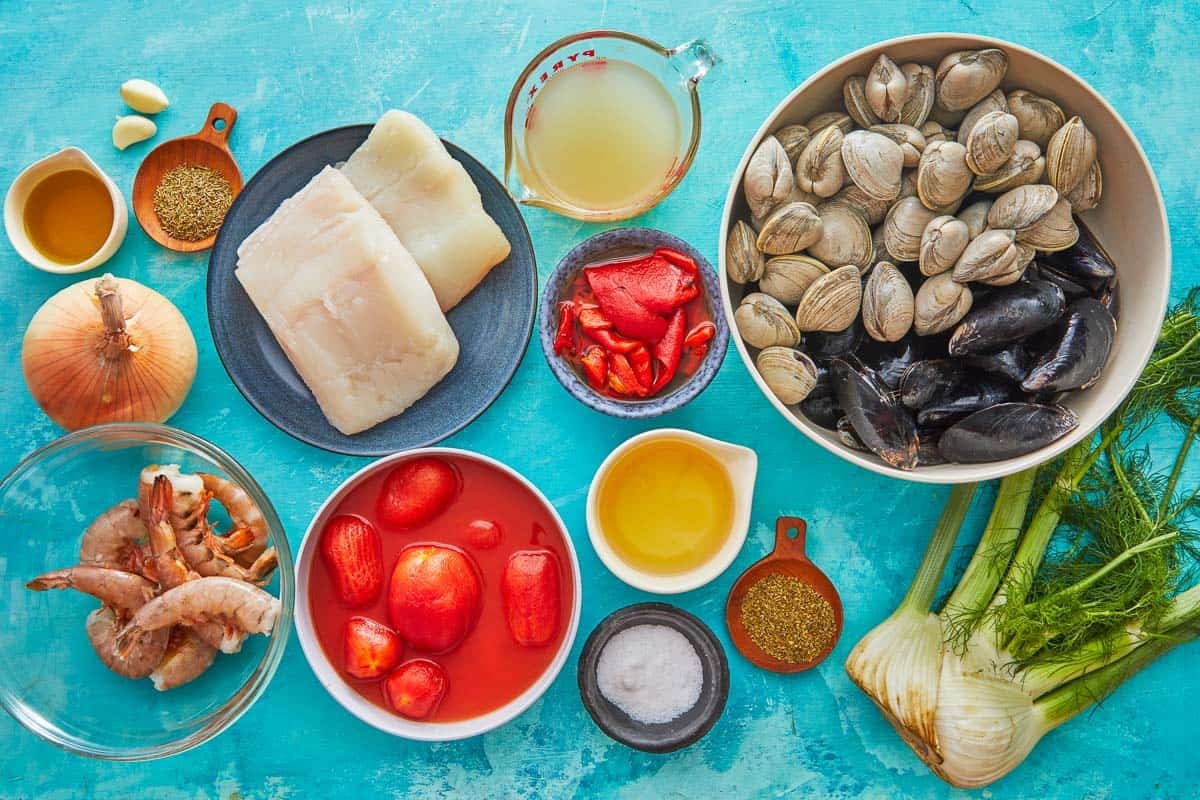
What is in Cioppino?
Really you can make this soup with any kind of fish or seafood you have on hand. It’s meant to use what was available during the day’s catch.
I’ve used a combination of clams, mussels, flaky white fish and shrimp for this version of cioppino because they’re easily accessible to most people, regardless of their proximity to the ocean. But if you’re lucky enough to have access to a wide variety of fresh seafood, feel free to use whatever fish you love the most!
Cioppino has as many variations as there are fish in the sea, so go wild with crab, lobster, cockles or scallops. The only type of seafood I would avoid in this stew are oily, dense fish such as salmon, trout or tuna.
Unsure of which fish to choose? Ask the person behind the seafood counter! The seafood should be of the highest quality, and very fresh.
- Seafood: Clams, mussels, halibut or cod (use what you can find), and shrimp give this cioppino a variety of textures, colors and flavors. Look for white fish that is firm and clean smelling, with no “fishy” odor. Clams and mussels should be alive meaning when you tap the shells they should close slightly. Avoid shrimp that smell like ammonia, a sign of spoilage. Shrimp should be firm and not slimy. In a pinch, frozen white fish and frozen shrimp can be used, although I much prefer fresh. Allow frozen fish to thaw overnight in the fridge before proceeding.
- Seafood Stock: High quality boxed seafood stock is available at most grocery stores these days, or if you’re feeling ambitious, try making your own! Can’t find seafood stock? Substitute bottled clam juice or low-sodium chicken stock instead.
- White Wine: Some versions of cioppino call for white wine, others for red wine. I’ve chosen to use white wine here because I think it plays nicely against the types of fish I used in the recipe, but if you prefer a heartier tasting stew, by all means use red wine. This is an infinitely adaptable dish with endless variations!
- Vegetables: Onions and fennel provide the backbone savory notes of the stew, while tomatoes and roasted red peppers round it out with warmth and bright acidity. I chose to use jarred roasted red peppers for their smoky notes and store-bought convenience, but if you’re feeling ambitious you can roast your own. Not a fennel fan? Try substituting celery or simply omitting.
- Gremolata: An herbaceous cousin of pesto, gremolata is traditionally a mixture of parsley, lemon zest, garlic and oil. I swapped out lemon zest for orange zest and added briny olives to complement the seafood in this dish. Adding this is optional, but I think you’ll love the pop of freshness that the gremolata provides! Do ahead: gremolata can be made up to 1 day ahead and refrigerated. Allow to come to room temperature while you prepare the cioppino.
How to Make Cioppino
Make the Parsley-Olive Gremolata: Combine parsley, orange zest, ½ cup olives, garlic, salt and red pepper flakes in a food processor and pulse until a chunky paste forms. Add 2 tablespoons of extra-virgin olive oil and pulse until the mixture is uniformly chopped and chunky. Set aside at room temperature and make the cioppino.
Steam the clams and mussels: Bring water to a boil in a large stockpot. In a steamer basket add the mussels and clams. Steam under a lid until just opened, 5-8 minutes. Remove steamer basket and place the opened mussels and clams in a large bowl. (Discard any that are unopened.) Reserve the steamer water.
Make the cioppino base: Set a large Dutch oven or 8-quart stockpot over medium heat and add extra-virgin olive oil. Add onion, fennel and salt. Saute until onion is translucent, 8-10 minutes. Add jarred red peppers, garlic, oregano and thyme to the pot. Saute until fragrant, 3-4 minutes.
Deglaze and make the stock: Deglaze pot with dry white wine, scraping any bits from the bottom of the pot, and allow the mixture to simmer for 5 minutes. Roughly crush whole tomatoes from a 28-ounce can with your hands and add them, along with any liquid from the can. Add 1 ¼ cup shellfish or seafood stock and 1 cup reserved steaming liquid to the pot and stir to combine. Bring mixture to a boil and allow to simmer, uncovered, for 20 minutes. Taste and add salt as needed.
Add the fish, shrimp, and finish: Add 1 pound flaky white fish, cut into 1-inch pieces and 1 pound peeled and deveined large shrimp to pot. Cover and simmer for 2-3 minutes, or until fish is opaque and shrimp are pink and curled. Remove pot from heat and stir in cooked shellfish. Taste broth and add salt, if needed.
Serve: Dish up heaping bowls, topped with a dollop of Parsley-Olive Gremolata and a side of grilled sourdough bread for dipping.

How to Peel and Devein Shrimp
Peeling and deveining shrimp is easier than you think. If this is new to you, use this cioppino recipe as a reason to learn a new skill. Once you’ve tried it you’ll wonder why you haven’t been doing it the whole time. Save the shells to make shrimp stock.
- Have a bowl of cold water prepared.
- Use a sharp pair of kitchen shears to cut down the “back” of the shrimp until you reach the tail.
- Peel off the shell, legs and tail of shrimp and discard. (Or save to make stock!)
- Use the tip of a sharp paring knife, remove the vein from the back of the shrimp.
- Swish the shrimp in the bowl of water to fully remove the vein and repeat with remaining shrimp.
How to Debeard Mussels
What looks like a scraggly beard hanging out of the mussel’s shell is actually a clump of elastic threads that anchor the mussel to solid surfaces. Most mussels come debearded, but it’s best to scrub their shells clean before cooking and check for any errant beards.
- To remove, simply grasp the beard between your thumb and forefinger and pull it towards the “hinge” of the mussel.
- If it’s difficult to grab the beard, you can use a paper towel to get a better grip.
- While clams don’t have beards, it’s best to give their shells a good scrubbing before cooking them as well.
Choosing the Best Wine for Seafood Stew
Wine is often used to deglaze pots when making soup because it adds a note of acidity to the soup and helps to balance the other flavors, but how to pick a great wine for deglazing soup and making cioppino? Read on for a few pointers.
- When choosing a white wine, look for a dry, unoaked variety such as pinot grigio, sauvignon blanc or chardonnay.
- Bonus points if it has “citrus” as a tasting note – seafood and citrus are a match made in heaven
- Choose a high-quality wine – no so-called “cooking wines” here, please!
- You’re only using 1 ¼ cups of wine in this stew, there will be plenty left in the bottle to enjoy with dinner.
- Abstaining from alcohol? Substitute low-sodium chicken stock for the wine.

How to Serve Cioppino?
Cioppino is traditionally served with grilled sourdough bread, what could be more quintessentially San Francisco than that? While this hearty stew is more than a meal on its own, a simple salad like our Lemon Parmesan Lettuce Salad or our Fresh Fennel Orange Salad would make a lovely side.
Be sure to set the table with not only spoons but also small forks to pry the meat out of the shellfish and a bowl to hold discarded shells. This is a delightfully messy stew to eat, so I recommend having lots of napkins available!
I hope it goes without saying that if you partake in alcohol you should absolutely serve the remaining bottle of wine you used in the stew to drink with dinner.
How Well Does Cioppino Keep?
This stew will keep in the fridge for 3 days after you’ve made it. You can also repurpose leftovers by making rice and combining it with some of the gremolata. Divide it into bowls, then spoon the seafood stew over the rice.
More Seafood Recipes
Mediterranean Diet Recipes
Mediterranean Shrimp Soup
Spanish
Easy Seafood Paella Recipe
Mediterranean Diet Recipes
Easy Mediterranean-Style Shrimp Stew
Try our Arbequina – California EVOO
An exquisite and versatile oil of mild intensity. It’s perfect for everyday use, and pairs especially well with seafood!

Browse all Mediterranean recipes.
Visit Our Shop.
Cioppino with Parsley and Olive Gremolata

Ingredients
For the Parsley-Olive Gremolata (Optional)
- 1/2 bunch parsley, about 2 ounces, roughly chopped
- The zest from one orange
- 1/2 cup mixed olives, pitted
- 1 clove garlic, peeled and roughly chopped
- 1/2 teaspoon kosher salt
- 1/2 teaspoon red pepper flakes, optional
- 2 tablespoons extra-virgin olive oil
For the Cioppino
- 1 pound clams, scrubbed well
- 1 pound mussels, debearded and scrubbed well
- 1/4 cup extra-virgin olive oil
- 1 large onion, cut into ½-inch dice (about 2 cups)
- 1 large fennel bulb, cut into ½-inch dice (about 2 cups)
- Kosher salt, to taste
- 2 cloves garlic, finely minced
- 1 12 ounce jar roasted red peppers, drained and roughly chopped
- 2 teaspoons dried oregano
- 2 teaspoons dried thyme
- 1 ¼ cup dry white wine
- 1 28 ounce can whole tomatoes
- 1 ¼ cup seafood stock
- 1 pound skinless firm white fish, such as halibut or cod, cut into 1-inch pieces
- 1 pound large shrimp, peeled and deveined
- Grilled sourdough bread for serving, optional
Instructions
Make the Parsley-Olive Gremolata:
- Make the gremolata: Place chopped parsley, orange zest, olives, garlic, salt and red pepper flakes (if using) in a food processor and pulse a few times to combine. Scrape down the sides of the food processor and add olive oil. Process until a uniformly chunky texture is achieved.
- Let the gremolata rest: Allow gremolata to sit at room temperature while you prepare the cioppino, to allow the flavors to fully bloom.
Make the Cioppino:
- Steam the shellfish: Prepare a stockpot with a steamer basket insert large enough to hold the clams and mussels. Bring 2 cups of water to boil in the stockpot, reduce heat to a simmer and steam mussels and clams under a lid until they just open, 5-8 minutes. Remove pot from heat and place all opened mussels and clams in a large bowl. Discard any mussels or clams that don’t open. Reserve the steaming liquid, about 2 cups.
- Saute the aromatics: In a large dutch oven or 8-quart stockpot, heat olive oil over medium until the surface just begins to shimmer. Add chopped onion, fennel and a hearty pinch of salt and saute until onion is softened and translucent, about 8-10 minutes. Add minced garlic, roasted red peppers, dried oregano and dried thyme. Saute until garlic is very fragrant and most of the liquid from the vegetables has evaporated.
- Deglaze the pot: When the red pepper mixture begins to look dry and sticky, add white wine. Use a wooden spoon to scrape up any vegetable bits clinging to the bottom of the pot. Bring mixture to a boil and simmer for 5 minutes.
- Finish the soup base: Crush whole tomatoes roughly in your hands and add them to the white wine mixture along with any collected juices in the can, seafood stock and reserved steaming liquid. Allow mixture to simmer for 20 minutes uncovered. Taste and add salt as needed.
- Cook the fish and shrimp: Add whitefish and shrimp to the pot and bring to a simmer. Cover the pot and cook for 2-3 minutes, or until the fish is opaque and shrimp are curled and pink.
- Finish the soup: Remove pot from heat and stir in mussels and clams. Taste and add salt as needed. Serve immediately, topped with a big spoonful of the parsley-olive gremolata.
Video
Notes
- Gremolata optional: The parsley orange gremolata is a special touch from me, but its totally optional and the cioppino is still delicious without it.
- Use the freshest seafood available: If you have a stockpile of fresh crab add it! Lobster? Why not? This is a catch of the day kind of stew!
- Switch up the fish: This recipe calls for cod or halibut but you can use any firm white fish.
- Visit our shop to browse quality Mediterranean ingredients including olive oils, spices, and more.





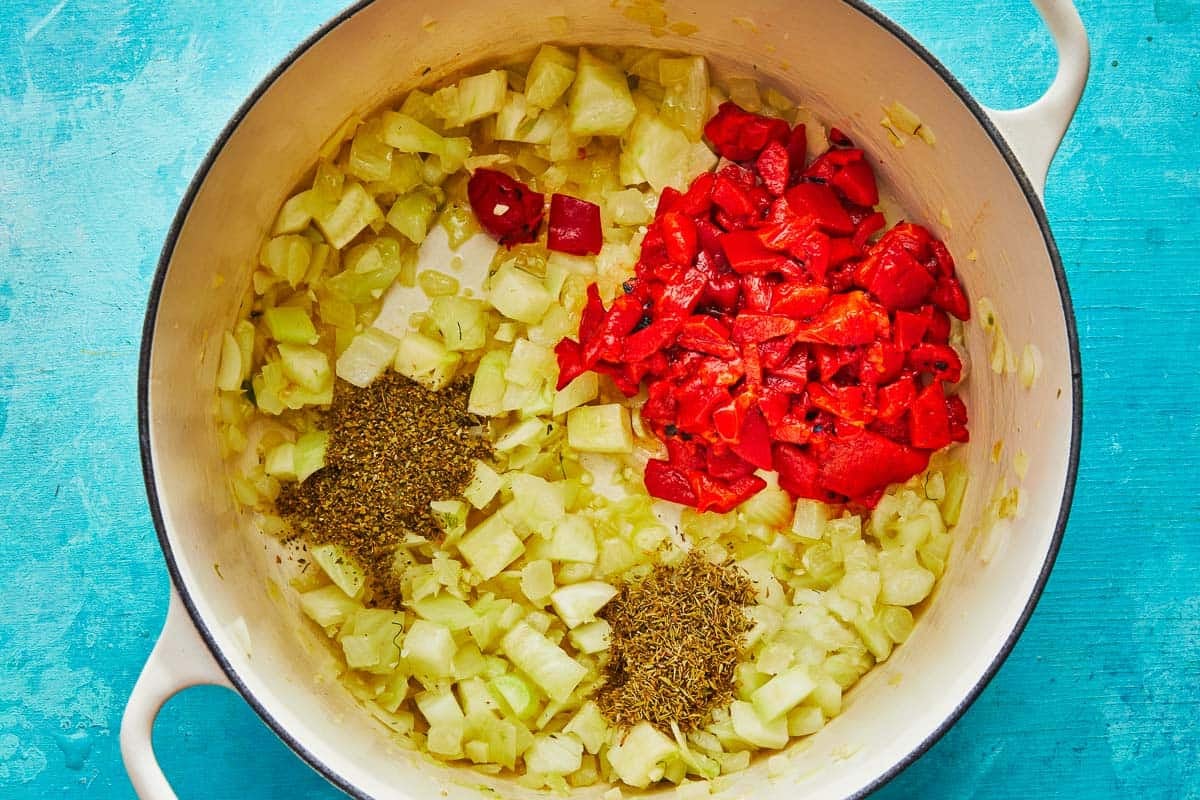

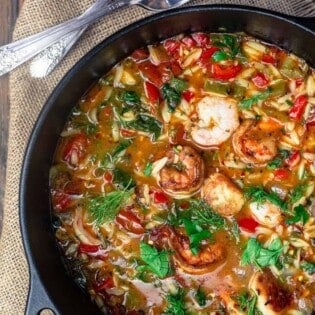



This recipe was easy to follow and the outcome was out of this world. My husband I thoroughly enjoyed the flavours this dish had to offer. Definitely a keeper and I look forward to serving the next time we have dinner guests.
recette réalisée aujourd’hui. d
Délicieux, pour la gremolata j’ai mis du zeste de citron (je n’avais d’oranges).
A refaire tellement c’était gouteux.
I’m mostly rating the gremolata as I married this and other cioppino recipes. The olive gremolata took the stew to new level. It was deelish!!! It worked well when I used the cioppino leftovers on pasta as well. Thank you!
ps – i took another recipe’s tip for cooking the fish separately which worked well and worth a try for others that may worry about overcooking expensive halibut 🙂
Thanks so much for taking the time to comment and review!
What combination of olives do you use?
Can you make any of this ahead of time? the soup base and gremolata? Maybe a day ahead?
Hi, Melanie! I’m Summer and I work here at The Mediterranean Dish! This is one of my all-time favorite recipes on the site! You can absolutely make the gremolata the day before — I would press plastic against it and store it in a tightly lidded container in the fridge. For the base, you can make it day ahead of time, however, the base uses some of the steaming liquid from cooking the mussels. So I would make the base without the steaming liquid from the mussels, then make the mussels the next day when you finish the soup and add the steaming liquid to the base then. Enjoy!!! I hope you love it.
Would like to make is there anyway this could be made ahead or does shellfish toughen up if it sits?
Hi, Janice! I’m Summer and I work here at The Mediterranean Dish. If you want to make part of it head of time and finish the rest the next day you certainly can. You can make the gremolata the day before, just press plastic wrap against and store it in a tightly sealed container in your refrigerator. For the soup, you could make the base, a day ahead, just leave out the steaming liquid from making the mussels. Then the next day when you steam the mussels stir some of the steaming liquid into the base and finish the soup. Enjoy! I love this recipe. I make it every year for Christmas.
I am always looking for a good Cioppino recipe, specifically for the rich tomato broth. Have borrowed from Duke’s, Anthony’s and even Trader Joe’s versions, and I think I’ve nailed a good broth that can be used for anything. Will certainly take a close look at this one, thanks!
BTW, “Cioppino” has no basis in Italian – the San Franciscan Italian fisherman coined the phrase after a long day fishing, prompting the others to “chip in” with their catch.
This recipe easily became a staple in my home. So delicious and flavorful, it feels like I’m in a restaurant every time I have it. I’ve made it so many times that it’s second nature now with just reminders needed sometimes. Definitely recommend this if it’s your first time! I was definitely scared with how involved it seemed, but it came out amazing. I sometimes leave out clams and mussels when I’m lazy and it’s perfect with cod and shrimp as well.
Thanks so much for sharing, Derek! It’s great to hear this recipe’s been a success for you!
Lots of stars but more low calorie recipes for 2 people would be appreciated.
Thank you
Pat
Noted, Pat! Thanks for the feedback.
Many Many!
Loved this recipe. Thank you. Five stars for sure.
Tried this recipe, it is absolutely delicious. Thank You!
So glad you enjoyed it, Michel!
I enjoyed this dish! I made it exactly as written, except for the fish. The Gremolata was a tasty addition to this recipe – thank you for sharing!
Our pleasure, Angie. So glad you enjoyed it!
Good but wasn’t great! One of the few dishes I didn’t feel was excellent.
Fantastic recipie! Substituted octopus for white fish. Will definitely make it again.
This was delicious> And I did not even have clams or mussels. The gremolata is perfect and added so much. Thank you.
So glad you enjoyed it, Sarah!
We had friends over Saturday night and made this seafood stew! It was amazing! We loved the gremolata. I prefer my cioppino a little spicier so next time I will add some red pepper flakes to the stew. I didn’t have whole tomatoes so I used a can of crushed tomatoes and it worked great. Thanks for the great recipe!
Glad you enjoyed it, Steve!